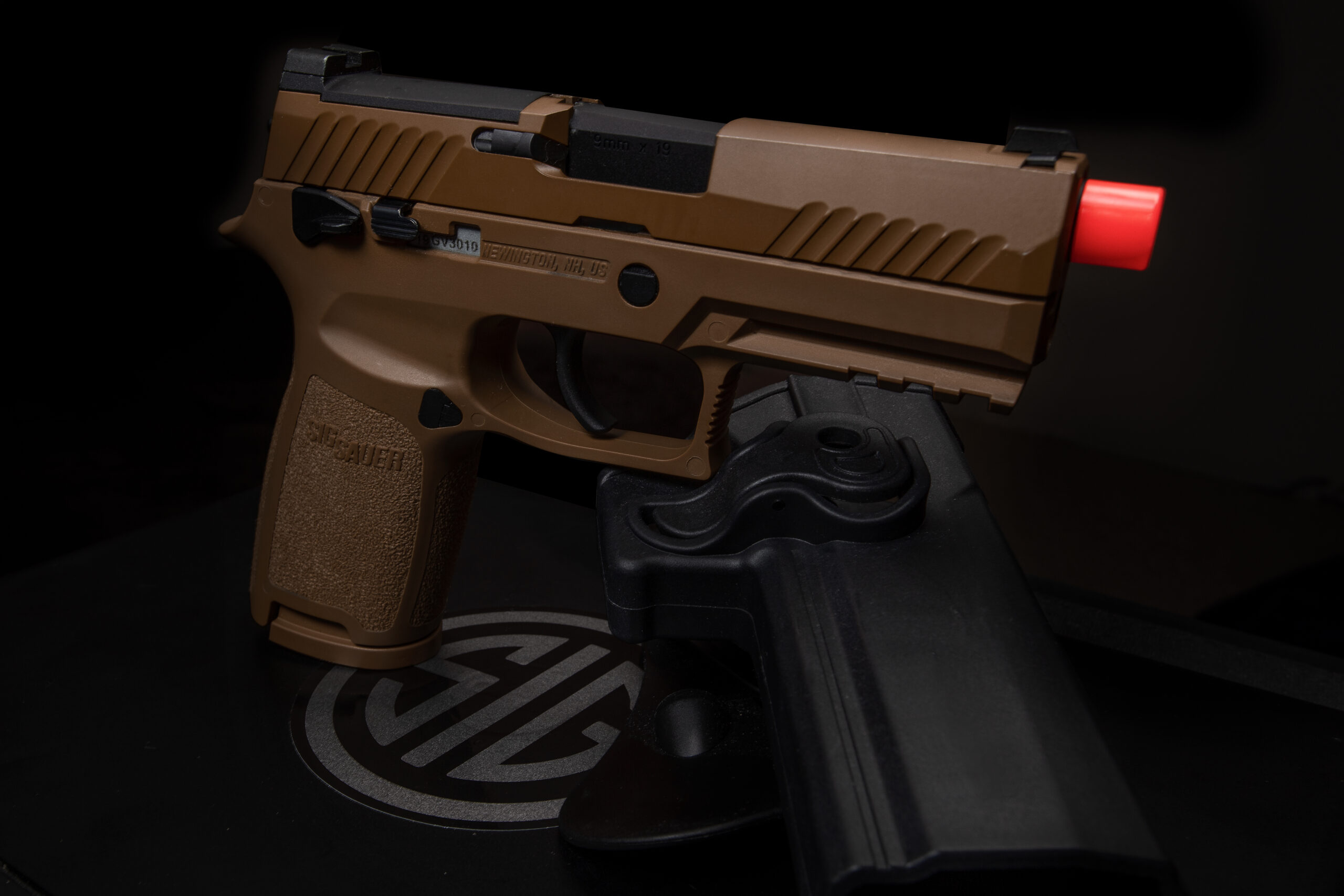SIG SAUER PROFORCE M18 Airsoft Training Pistol
Force-on-force training is a vital component of any tactical or self-defense curriculum, as it allows participants to test their skills and decision-making abilities in realistic scenarios. However, not all force-on-force training methods are created equal, and there are pros and cons to each option. In this article, we will compare two of the most popular and widely used methods: Airsoft and Simunition®. We will also briefly mention some other force-on-force training methods that are available.
Airsoft is a type of replica firearm that shoots plastic pellets, usually 6mm in diameter, propelled by compressed gas or electric motors. Airsoft guns are designed to mimic the appearance and function of real firearms, but they are generally much cheaper and easier to obtain. While it is often seen as a recreational activity, Airsoft can also be used for serious training purpose.
Simunition is a brand name for a type of non-lethal ammunition that is used in specially modified firearms. Simunition projectiles are similar to paintballs, but they are smaller and more accurate, and they can be fired from real firearms with realistic recoil and noise. Simunition is mainly used by military and law enforcement agencies for training purposes.
Airsoft vs. Simunition
Both Airsoft and Simunition have their advantages and disadvantages for force-on-force training. Here are some of the main factors to consider when choosing between them:
Safety: Both Airsoft and Simunition require proper safety equipment and procedures to prevent injuries. Airsoft pellets can cause bruises, welts, or eye damage if not protected by adequate clothing and eye protection. Simunition rounds can cause more severe injuries, if not protected by special protective gear and clothing. According to Simunition’s Training Range Program Guidelines, improper use of Simunition ammunition can cause injury, loss, damage or death. Users need to exercise the same firearm handling precautions as with live ammunition. Simuntion is designed to be used in firearms that have been modified to only accept Simunition rounds. These firearms are designed to be incapable of being loaded with live round. However it is still important to check and clear firearms before use, even when using Simuition.
Cost: Airsoft is generally much more affordable than Simunition, both in terms of initial investment and ongoing maintenance. Airsoft guns can range from $20 to $500, depending on the quality and features, while Simunition guns can cost thousands of dollars, as they are modified versions of real firearms. Airsoft pellets are also much cheaper than Simunition rounds, which can cost up to $1 per shot.
Availability: Airsoft is widely available and accessible to anyone who wants to use it for training purposes. Airsoft guns and pellets can be purchased online or at local stores, and there are many Airsoft fields and clubs that offer rental equipment and organized games. Simunition, on the other hand, is restricted to authorized users only, such as military and law enforcement personnel. Simunition guns and rounds can only be purchased from authorized dealers, and there are fewer facilities that offer Simunition training.
Realism: Simunition offers a higher level of realism than Airsoft, as it uses real firearms with realistic recoil, noise, and ballistics. Simunition training provides a high level of realism and stress for the trainees, Simunition training also enables more accurate feedback and evaluation of performance, as the hits and misses are clearly visible. Airsoft guns, while resembling real firearms, do not have the same weight, feel, or performance as real guns. Airsoft pellets also do not create visible marks on the target, which can make it harder to determine hits and misses. Simunition training is more suitable for advanced and specialized training, such as force-on-force scenarios, hostage rescue, or close quarters combat.
Accuracy. Generally speaking, Simunition has significantly greater accuracy than Airsoft, because it has a higher muzzle velocity and a higher ballistic coefficient than Airsoft pellets. However, both are sufficiently accurate for most force-on-force training scenarios,
Pain: Pain is a subjective factor that can affect the quality of force-on-force training. Some people argue that pain is necessary to create stress and adrenaline, which can enhance the learning experience and simulate real combat situations. Others argue that pain is unnecessary and counterproductive, as it can cause fear, hesitation, or anger, which can interfere with the learning objectives and create bad habits. Airsoft pellets cause less pain than Simunition rounds, which can make Airsoft more suitable for beginners or those who prefer a less painful experience. Simunition rounds cause more pain than Airsoft pellets, which can make Simunition more suitable for advanced or professional users who want a more challenging experience.
Other Methods: Airsoft and Simunition are not the only force-on-force training methods available. There are also other options such as laser tag, paintball, blank rounds, or role-playing with no weapons at all. Each method has its own benefits and drawbacks that should be evaluated according to the specific needs and goals of the participants.
In conclusion, Airsoft and Simunition are both viable options for force-on-force training, but they have different strengths and weaknesses that should be considered before choosing one over the other. The best method depends on the goals, budget, availability, preferences, and skill level of the participants.
Sources
EVIKE.com
Evike.com
SIG SAUER
SigSauer.com
Simunition
Simunition.com
*The views and opinions expressed on this website are solely those of the original authors and contributors. These views and opinions do not necessarily represent those of Spotter Up Magazine, the administrative staff, and/or any/all contributors to this site.
